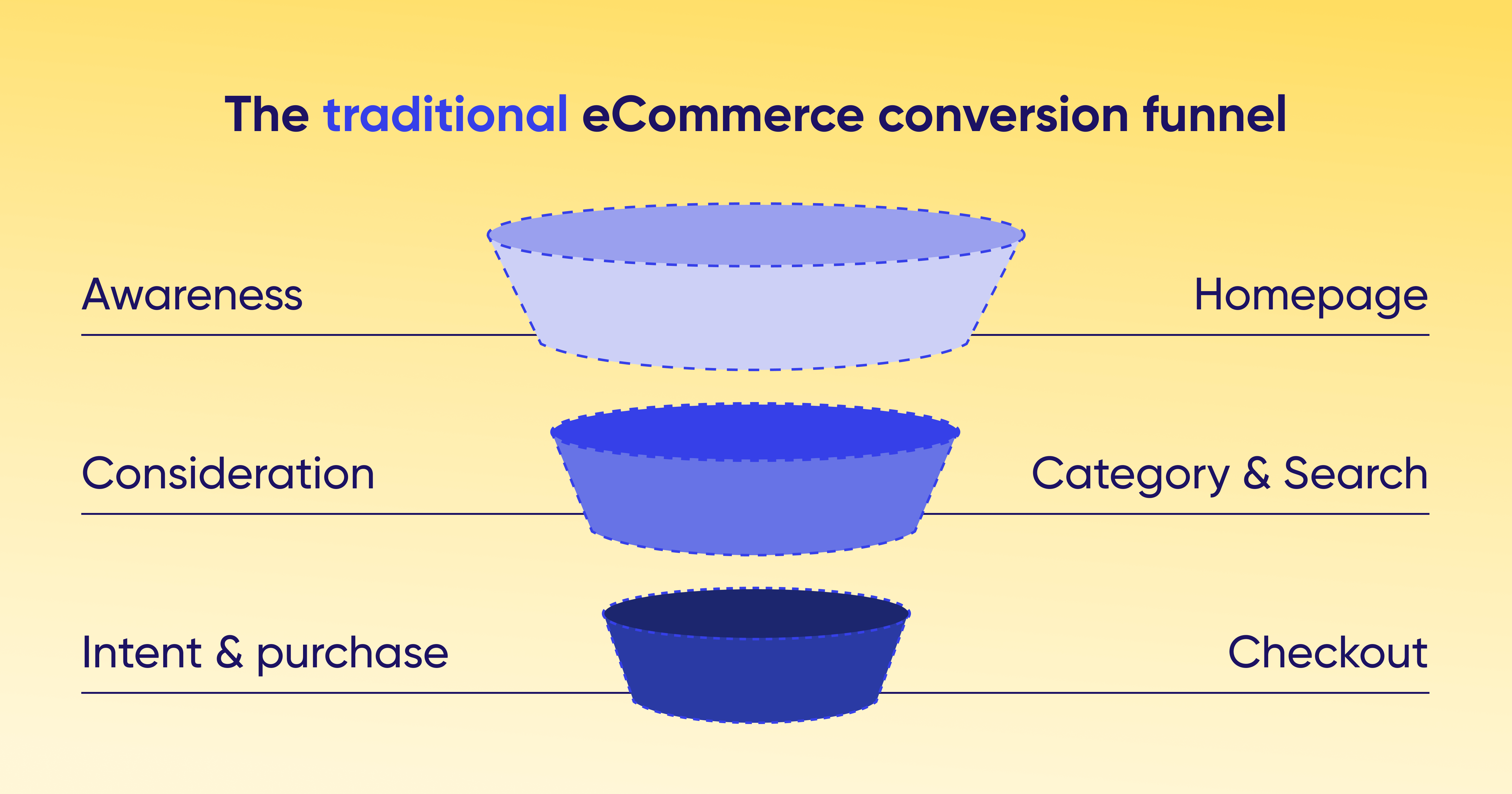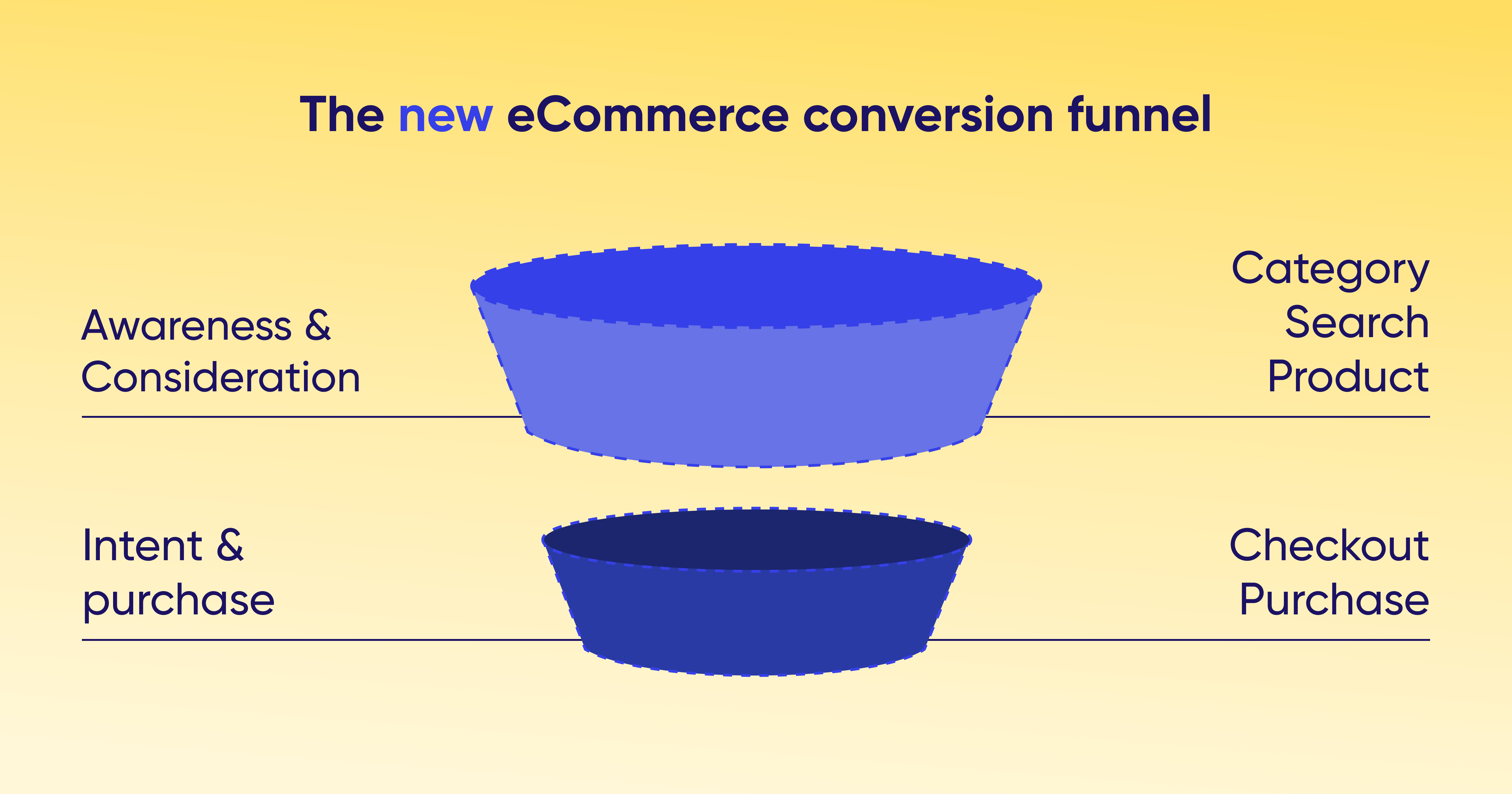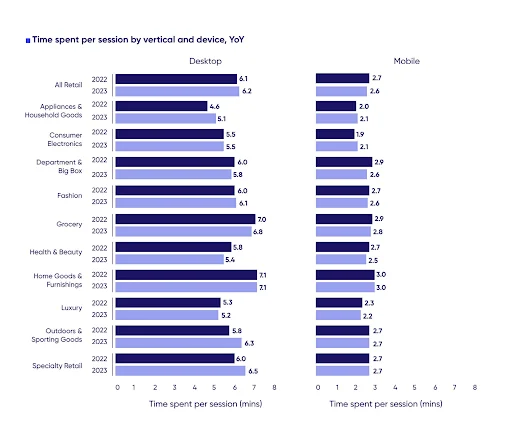
See how your digital experience stacks up.
Download the 2024 Retail Digital Experience Benchmark Report for the metrics that really matter.

The transformation of the eCommerce conversion funnel is a major paradigm shift that digital eCommerce teams can’t afford to ignore.
For starters, it helps explain the -5.8% Year-on-Year drop in eCommerce conversion rates that we saw last year—and the accompanying dip in session consumption metrics such as time spent per session.
We lay out exactly how much these metrics dropped across 10 retail sub-industries in 2023 in our recent 2024 Retail Digital Experience Benchmark report, which we link to below. (You can also read a summary of the report’s key findings.)
To accompany the report’s release, we’re lending retailers a hand in addressing its diagnosis of conversion rate decline by publishing a series of articles on eCommerce conversion rate optimization. (This in-depth, albeit more general, article on conversion rate optimization should also help.)
In this article, we draw on findings from the benchmark report to investigate why the eCommerce conversion funnel is changing—and why this change demands a new approach to conversion rate optimization for retailers.
See how your digital experience stacks up.
Download the 2024 Retail Digital Experience Benchmark Report for the metrics that really matter.
Marketers use funnels to represent the customer journey from ‘top of the funnel’ (TOFU) awareness through ‘middle of the funnel’ (MOFU) consideration to ‘bottom of the funnel’ (BOFU) conversion. The object is to get as many customers from the top to the bottom of the funnel.
A narrowing funnel shape is appropriate because while awareness casts a wide net and (ideally) brings in a big audience, only a minority of those who become aware of a brand will end up buying something from it—and there’s a steady drop-off along the way.
Traditionally, the on-site eCommerce funnel has been mapped out like this:

With this model in mind, retailers have been spending lots of time curating stories and working on TOFU (homepage-based) content to raise brand awareness, attracting new customers who can be nurtured further down the funnel towards conversion and retention.
But things have changed. For an increasing proportion of visitors to eCommerce websites, the homepage is no longer the first port of call—and they’re entirely bypassing the traditional TOFU.
So why is this happening?
In the world of eCommerce, the conversion funnel is a critical component for businesses looking to increase their sales and revenue. It is a marketing concept that describes the journey a customer takes from the initial introduction to a product or service to the final purchase. Understanding the different stages of the conversion funnel is essential for eCommerce businesses to optimize their sales funnel and convert more visitors into customers.
The eCommerce conversion funnel consists of four main stages:
By analyzing each stage of the eCommerce conversion funnel, businesses identify areas to optimize their marketing efforts or improve the user experience on their website. This helps improve conversion rates and generate more revenue for the business.
Why can the eCommerce conversion funnel change depending on the industry? Because of the distinct nature, needs and goals within each industry.
For example, an eCommerce store selling fashion may want to focus on getting users to view a product page and add items to their cart, while an eCommerce store selling electronics may want to encourage users to read product reviews before making a purchase.
Different industries require different approaches, and the conversion funnel should be tailored to the industry in order to maximize conversions.
Here’s another example of how different a conversion funnel might look in the retail and travel eCommerce industries.
For a growing segment of eCommerce site visitors, the top of the eCommerce conversion funnel is (depending on how you look at it) being skipped entirely or is ‘sinking’ below the traditional top-of-funnel level.
The new eCommerce conversion funnel looks more like this:

You can find evidence of this evolution in the findings in our 2024 Retail Digital Experience Benchmark report.
The report shows that customers are increasingly alighting on eCommerce sites via paid search and social campaigns (not to mention influencer marketing).
And these channels and campaigns often bypass the traditional top of the funnel, fast-tracking visitors directly to product description pages.

Traffic share by channel, year-over-year
The eCommerce conversion funnel is also shortening as average session time dwindles.
Retail is one of the most mobile-led industries (with 3 in 4 (77%) visits to eCommerce sites in 2023 coming from mobile visitors)—and in 2023, mobile visitors spent an average of only 2.6 minutes on eCommerce websites—under half the time (6.2 minutes) that desktop users spend.

Time spent per session, by device, by industry vertical, year-over-year
The erosion of the traditional top of the eCommerce conversion funnel—and of time spent per session—has big implications for retailers looking to convert visitors into (ideally returning) customers.
Here are three things we suggest you do to adapt:
“Instead of spending the majority of your time and effort thinking about what you want to do higher up in the funnel, you should be thinking:what do we need to get across at PDP level from a story? How do we tell the story deeper in the funnel? Because that’s clearly where customers are migrating to.”
–Tom Parker, Site Optimization Manager, Marks and Spencer
Brand stories are extremely important. They differentiate your business in the eyes of consumers and help build loyalty and lifetime value—vital when considering the hefty expense of relying on paid and new traffic.
When visitors come to your eCommerce brand through the top of the funnel, you have ample opportunities to tell them your brand story, showcase your identity and progressively nurture the sort of relationship with them that will keep them coming back in future.
However, with an increasing chunk of visitors (particularly new-to-you visitors) now coming in via paid campaigns and straight on product pages, you can no longer assume they’ll be exposed to that top-funnel story—or at least, not on the pages where TOFU content traditionally sits.
And given the decreasing time spent per session, particularly on mobile, they’re not necessarily going to have (or want to spend the) time to familiarize themselves with your non-product pages.
That’s why you need to think about working your brand story into the pages visitors are arriving on first: category and product pages.
A product page now needs to sell more than the product itself—it needs to sell your brand, too. Category, search and even checkout pages also need to pull more weight.
With a myriad of traffic sources now bringing visitors to eCommerce sites, segmenting your audience is more important than ever.
Segmenting when analyzing customer behavior helps you understand what each type of visitor is motivated by. This lets you be mindful of that motivation when tailoring your experience to serve each visitor a personalized experience, based on the segment they belong to, that takes them exactly where they want to go, as fast as possible.
This awareness needs to extend to the device they’re using to interact with your experience. Desktop users may have more appetite for delving into your product range, or consuming in-depth content that familiarizes them with your brand.
Mobile users, by contrast, will probably be less inclined to browse around your website and delve deep into content, especially if they’ve arrived via a paid ad campaign that highlights a particular product. For them, efficiency will be paramount.
Data from the 2024 Retail Digital Experience Benchmark report shows that shoppers viewed 2.3% fewer pages per session than last year. These sessions tend to be shallower than ever before—especially on mobile. Across all retail, the average page views per session is 6.1 on desktop, while smaller screen visits only run up to an average 4.8 pages.
This insight highlights the need to continue optimizing product pages—including out-of-stock product pages—and encourage users to view more product pages with ‘You may also like’, ‘Wear it with’, ‘Bestsellers’ carousels.
However, when it comes to certain consumer segments, a low session depth doesn’t necessarily indicate a failure to convert—far from it. In fact, the evolution of the eCommerce conversion funnel suggests that many customers want to get deeper into the journey faster—and get to the checkout as fast as possible.
“Every detail matters. When you go through your site page by page, write down anything that bothers you. When you test these small things and take a data-driven approach to optimization, you’ll find a lot of savings in the details. It’s all about making a frictionless purchase experience for your customers.”
—David Ting, CTO, Zenni Optical
When optimizing your customer journeys, prioritization must go to the pages customers are engaging with most frequently: Category, Product and Search.
But with entry points to your sites now being so varied and unpredictable, it’s absolutely imperative that you have a clear understanding of what’s going on at every stage of the customer journey.
The fact is that wherever in the funnel your visitors are when they’re on your website, they’ll be frustrated by friction and engaged by user experience design that encourages them to interact. To that extent, at least, the on-site conversion funnel matters less than the overall experience.
And what you should be aiming for with that experience is to remove friction (such as, but not limited to, slow loading pages) and increase engagement (and user activity) throughout.
For the full details on what’s causing friction in eCommerce experiences—and about the value of promoting user activity, check out our report.
See how your digital experience stacks up.
Download the 2024 Retail Digital Experience Benchmark Report for the metrics that really matter.
Only by having (properly segmented) insight into how customers are behaving on every page on your website—and why they’re behaving that way—can you ensure that your experience is truly optimized for conversion from end to end.
And only an AI-powered Digital Experience Analytics (DXA) solution like Contentsquare’s Digital Experience Analytics Cloud will give you that insight.
(It will certainly save you from trawling through your website and writing everything down as David Ting suggests above, though you should still keep your notepad handy!)
Unlike traditional analytics solutions, our DXA platform doesn’t stop at showing you how many visitors are arriving on your website, clicking on stuff and bouncing, exiting or converting.
It also shows you what’s going on between clicks (via Zone-Based Heatmaps), how customers are progressing through your site (via Customer Journey Analysis) and what the root causes of customer behavior (via Session Replay).
Plus, platform features like CS Insights leverage machine learning to bring high priority client-side issues (such as technical errors) to your attention before they lose you customers.
To learn more about how leading eCommerce have used Contentsquare to optimize their experiences, check out our article on eCommerce conversion rate optimization strategies.
Or why not see for yourself what Contentsquare can do for your website and your eCommerce conversion funnel with a quick product tour?
Take a product tour Get to grips with Contentsquare fundamentals with this 6 minute product tour.